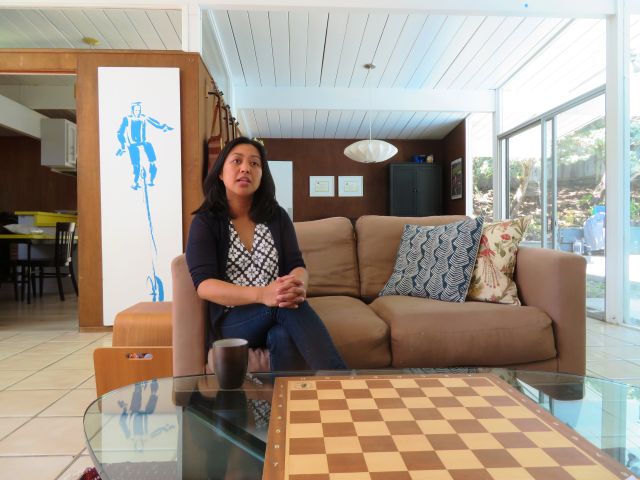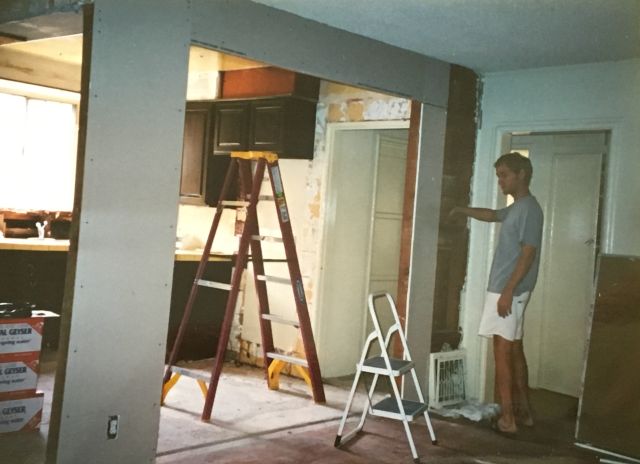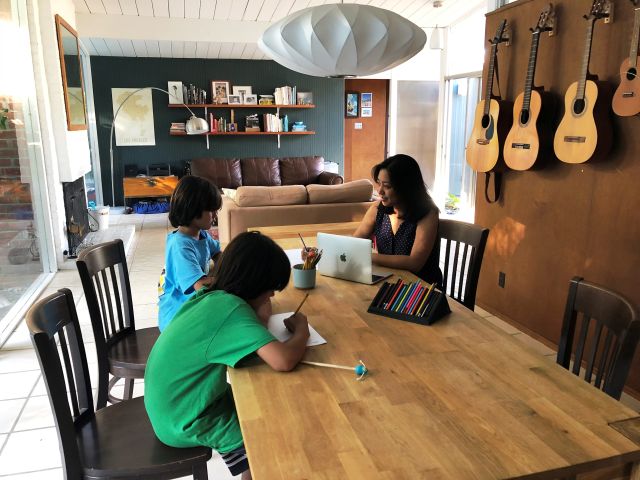
Eichler Inspires a Novel About Building
 |
|
|
It’s a beautiful spot, a magical spot, a spot tinged with sadness. There are redwood trees, a shallow creek ideal for a girl to dip her feet, and “a rusty old trailer bed.”
It’s a plot of land in suburban Marin County that was bequeathed to a young 'half Filipino' girl Lou by her dad, who died too soon. She knows what she wants to do with the land – build a tiny house on it to honor him and because…
Well, let’s not give away the plot of this young people’s novel that is so good it can make an adult male tear up.
But consider Lou’s situation, in a small home in San Francisco, living with her mom and grandmother, Lola. “There’s only one spot in Lola’s home I can call my own,” Lou observes. “The bedroom closet.”
Also consider some of what the author of ‘The House that Lou Built’ was thinking about as she brewed up the plot. Mae Respicio, who grew up in Stockton and lived in Los Angeles for 15 years, had just moved into an Eichler in Marinwood.
“I was feeling very homesick for Southern California,” she says, “ and wondering how my boys were transitioning in moving and leaving all their family and friends.”
 |
|
|
The novel, which was published by Random House last month, is Mae’s first. Random House has already bought her second, another coming-of-age book for young people, which it will publish circa 2020.
Mae, who lives today in her second Eichler home, in Marin’s Terra Linda, says the novel’s focus on architecture was inspired in part by her living in an Eichler. She began to “think a lot about what makes a home.”
“Suddenly we are living in this wonderful Eichler and feeling very inspired by the community and the people there, and the actual physical space, and I thought, ‘Oh why don’t I talk about a kid who is exploring the meaning of a home?’ And I thought, ‘Oh, and I’ll throw in some Eichler details there.'”
One important, inspirational character, who teaches woodworking in Lou’s school, does live in a Marin Eichler home, and one scene is set there.
Other inspirations for the plot, which goes into detail on why and how young Lou sets about to build a home-on-wheels, included her own sons, Cael and Alden.
“I watch my kids,” she says. “They find a lot of joy in making things with their hands. I thought I’d like to explore that.”
 |
|
|
Also, Mae says, “I don’t think there are any middle-grade novels for kids that revolve around building or architecture or things of that nature.” She adds, “Tons of books explore the theme of home, but as far as a girl interested in building something with her hands, there isn’t really anything out there that I was able to discover.”
“There is just something inspiring to me about that young voice,” she says about her decision to write a young person’s novel, “when you can have a character, and they are exploring their world for the first time.”
The book does a great job capturing Lou’s extended Filipino family and her many friendships, and plays up the challenges facing Lou as she battles parental control and rules, and many doubters, to work with hammers, nails, and wood.
“Girls don’t build houses,” one friend tells her. “They only vacuum them.”
Lou is a particularly appealing character, smart and determined. Mae, who is also of Filipino background, says the novel is not autobiographical. “[Lou] is the girl I wanted to be very persistent and smart, and she finds solutions to things. But she is very much a [fictional] character.”
The book also captures what life is like in the Bay Area for kids – or at least kids brave enough to take long bus rides to hidden spots in Marin without telling their moms.
 |
|
|
Helping make the house building real for Mae is the experience she and her husband, Mark Koerner, had when they were remodeling their home in West Los Angeles, “a total fixer-upper.” They did much of the work themselves.
“I was using circular sanders,” she says. They took classes in how to grout, and took down a wall in the kitchen. “It was a huge learning experience,” Mae says.
Mae, who moved to her first Eichler six years ago and to the current one in 2015, has a background in writing. She moved to Los Angeles with a dream of writing screenplays, and ended up working in the industry. She met her husband, an artist and product designer, when both were working for Disney. You can see his work in ‘Tarzan’ among other animated films.
She’s done much nonfiction writing, often for parent and family publications, and has worked for academic writing programs, including at UCLA and UC Berkeley. Today Mae works as a freelance editor for websites, often from home.
Much of her novel writing took place around her dining table, often at night as the kids slept.
Mae and Mark knew about Eichlers before relocating to the Bay Area, because they had a friend in LA who had grown up in one. They focused on finding one.
Mae hopes the book gets girls more interested in architecture – and in Eichlers.
“It can spark kids’ interest in a lot of ways. And I thought the Eichler element was a fun way to get them interested, too, in what it means to live in a really unique house.”
Check Mae Respicio's website for book talks.
- ‹ previous
- 181 of 677
- next ›



